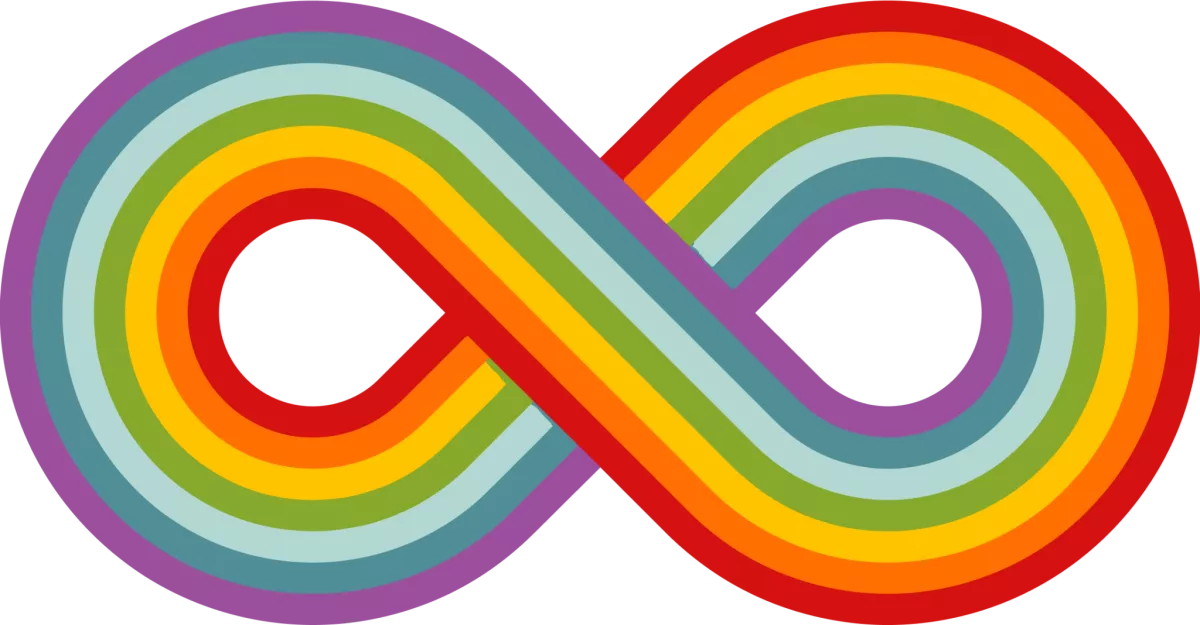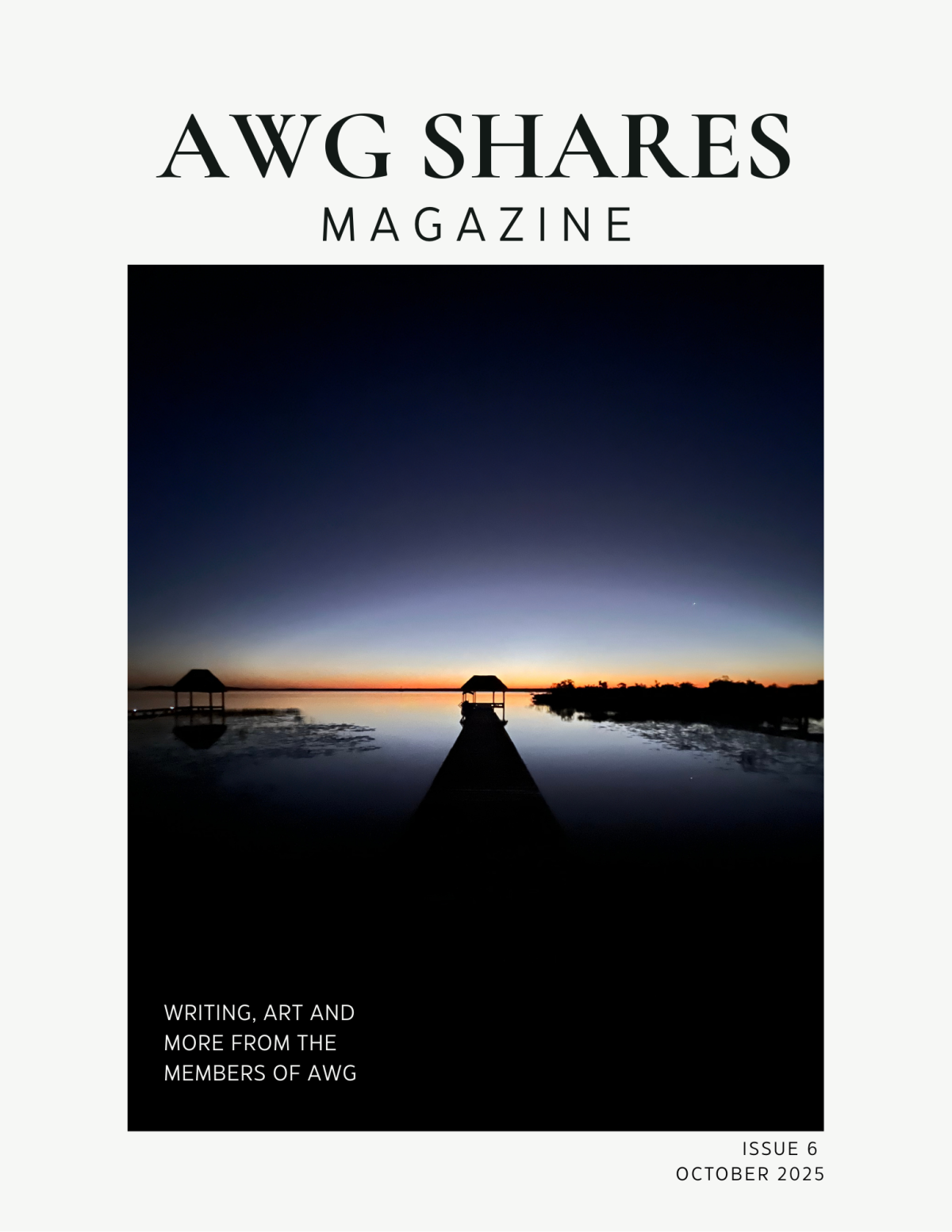
Contents
October 2025 • Vol. 1, Nr. 6
Editorial Dept.
Annie Mydla
Sol Iacob
Cover
Elissa Fox
Intro
About Autistic Women's Group • Annie Mydla
About This Month's Cover
Bacalar Lagoon • Elissa Fox
Quotes of the Month
Autism Chrysalis Life Coaching
When You Hate Being Perceived • Heather Cook
When You Hate Being Perceived • Heather Cook
Trigger warning: Self-harm, suicidality
Essay
A Blonde, a Redhead, and a Brunette Meet in Quito: Ecuador Stories Part 3 • Stevie Lou Díaz
A Blonde, a Redhead, and a Brunette Meet in Quito: Ecuador Stories Part 3 • Stevie Lou Díaz
Art Inspired Writing • Christina Donaldson
Comics
Bathrobe Gal: Trees • Sarah Jane Cody
Sticker
Introvert • Elissa Fox
About Autistic Women's Group
Established 2021
AWG is an online support group for late-identified autistic women and all other members of marginalized genders. The meeting format is designed to reduce the sensory, social, and executive function burdens that normally come with socializing. Our members are clinically-diagnosed, self-diagnosed, and questioning. AWG is volunteer-led and not associated with any other umbrella organization or company.
Please consider joining us on Zoom. Our member profile is inclusive. Meetings are always free and no registration is required. Members share by speaking or typing. We also have many members who come just to listen. You never have to turn on you mic or camera if you don't want to. You don't have to come to every meeting, or stay the whole meeting, in order to be a full member. Disclosure of diagnosis/gender identity is welcome but never required for participation.
Click her to learn more about attending a meeting. You can also...
- See upcoming meeting topics
- Sign up for meeting reminders (scroll the homepage to find the signup form)
- Join the AWG subreddit
I hope you enjoy AWG Shares Magazine. And please do join us in a meeting sometime if you can.
Annie Mydla
Founder and facilitator, AWG
About This Month's Cover: Bacalar Lagoon
Elissa Fox
During a family vacation to Mexico in 2024 I found myself often overwhelmed and over stimulated. The big dinners and constant loud music was making me absolutely miserable. It’s a special kind of hell to be miserable on vacation. I started making a little game out of how often I could get away by myself without being noticed. I found the best time was in the early mornings before anyone was awake. I would sneak out to the beach with a hot tea and watch the sunrise. This morning was particularly spectacular as the sun rose on the Bacalar Lagoon. I felt so grateful to be in my own company sharing my favorite part of the vacation. Sometimes I feel quite lonely in the presence of others, but when I can get away and just “be” with myself, I often delight in my own company. Getting this shot felt like a reward from the universe for taking care of myself and trusting what I need.
Quotes of the month
Quotes relating to autism and AWG values by autistic and non-autistic people. Have a quote you'd like to share?
Send it for inclusion!
Send it for inclusion!
“I think in many ways that we autistic are the normal ones and the rest of the people are pretty strange, especially when it comes to the sustainability crisis where everyone keeps saying that climate change is an existential threat and the most important issue of all and yet they just carry on like before.(...)To me that is black or white. There are no gray areas when it comes to survival. Either we go on as a civilization or we don’t.”
― Greta Thunberg, Ted Talk: School Strike For Climate
“It does not matter what sixty-six percent of people do in any particular situation. All that matters is what you do.”
― John Elder Robison, Be Different: Adventures of a Free-Range Aspergian
When You Hate Being Perceived
Heather Cook, Autism Chrysalis Life Coaching
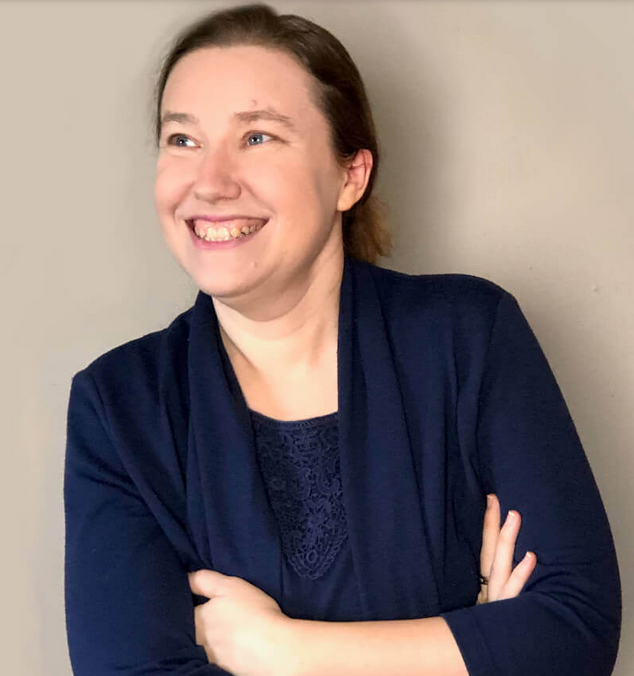
Here's what might be going on if you hate being perceived, if it feels bad or awful, especially if you're Autistic or otherwise different from the majority around you. I struggled with this, and this is my theory of what's going on, and my real life experience of undoing the damage so I could make new associations for a better future.
See a full transcript of the video at https://www.autismchrysalis.com/2023/12/09/when-you-hate-being-perceived/
Visit Autism Chrysalis and follow Heather on social media:
Website: www.autismchrysalis.com
YouTube: https://www.youtube.com/@autismchrysalis
X/Twitter: https://twitter.com/hmm_cook
Mastodon: https://universeodon.com/@hmm_cook
Instagram: https://www.instagram.com/autism_chrysalis
BlueSky: https://bsky.app/profile/autismchrysalis.bsky.social
YouTube: https://www.youtube.com/@autismchrysalis
X/Twitter: https://twitter.com/hmm_cook
Mastodon: https://universeodon.com/@hmm_cook
Instagram: https://www.instagram.com/autism_chrysalis
BlueSky: https://bsky.app/profile/autismchrysalis.bsky.social
UK Black History Month: Celebrating Black Autistic People
October is Black History Month in the UK. While all months of the year should be a celebration of Black people’s history and voices, Black History Month is surely an opportunity to learn and put Black history and communities at the forefront of our attention.
There is not much information online about Black autistic historical figures. Racism and the pathologization of autistic behaviours have overlapped to create, sadly, a historical erasure of Black autistic people. When autistic historical figures are mentioned, they are usually white and Western (as a quick web search will show) – such as Einstein or Darwin, or more recently, Greta Thunberg.
Still, Black autistic people have always existed and contributed to society, and there are some Black autistic historical figures whose lives have reached our collective memory through history. The platform Locating Black Autism does a great job of describing some of these figures from 1700s to the present, with the caveat that:
We recognize that many of the individuals mentioned were ones that were perceived to be an “autistic savant.” We found it important that those that might not fall under this category of being autistic and having “savant syndrome” deserve to have their story recognized as well.
From “Blind” Tom Wiggins, a self-taught pianist and composer born enslaved in 19th-century America, to Benjamin Banneker, an African-American scholar during the 18th century, Black autistic people have always defied racism and ableism with their existence and self-expression. I recommend visiting the page of Locating Black Autism to read the short biographies of these and other Black autistic historical figures.
History is not only in the past, but it is always becoming through the present. As the autistic community grows stronger in numbers and self-awareness, and as it advocates for equality with the neurodiversity paradigm, the voice of autistic people has been getting louder and louder, emerging from a historical silence. Sadly and in spite of many social changes however, this increasing recognition is not equally distributed, and to this day the experience of Black autistic people is often still marginalized and targeted in multiple ways, and still not given the recognition, support and value that it deserves. As a white autistic person, I think that it’s really important for the emergent and rapidly changing autistic community to be aware of these dynamics as well as to be a space of active solidarity where everyone is equally celebrated and supported.
Black autistic creators said it better than me (or talked about something else entirely):
- Actually adulting – Blog and podcast by Tyla Grant
- All the Weight of Our Dreams: On Living Racialized Autism (anthology)
‘Delve into poetry, essays, short fiction, photography, paintings, and drawings in the first-ever anthology entirely by autistic people of color, featuring 61 writers and artists from seven countries.’
'The Autistic People of Color Fund practices redistributive justice and mutual aid by returning and sharing money directly to and with autistic people of color. We provide microgrants to Black, Brown, Native, Asian, and mixed-race people in the autistic community for survival, organizing, leisure, and pleasure.’
- Black and Autistic in Neo-Nationalist America – (by Timotheus Gordon Jr, The University of Illinois at Chicago)
- Breaking Me Down and Lifting Me Up: An Autoethnography of Being a Black Autistic Woman Online – (by Morgan Harper-Nichols - Lindenwood University)
- Cultural Bias and Disability: We Have to do Better with Children of Color – (by author Lamar Hardwick)
- Reclaiming My Identity as An Autistic, Biracial Black Trans Man with Multiple Disabilities on World Kindness Day – (by Kris McElroy)
- “They Don't Know, Don't Show, or Don't Care”: Autism's White Privilege Problem - (by author and advocate Morénike Giwa Onaiwu)
- To Be a Black, Autistic Woman. Melanated, feminine, and on the spectrum - (by writer Ms. KJ)
- Too Autistic for Black – Documentary on being ‘Black, British and Autistic’ – (by Writer / Director Tee Cee – Streaming on discovery+)
'I wanted to highlight the experiences of what it’s like to be black, British and marginalised in the autism discourse as well as celebrating black, autistic lives… celebration was particularly a fundamental element in my story-telling because sometimes the media feeds off trauma porn and the black struggle, which perpetuate single narratives and stereotypes.’
For more Black autistic social media creators:
My body is littered with scars, and what I truly believe
Emmie
Trigger warning: Self-harm, suicidality
I don’t have a clever or funny title for this one. Instead I have clumps of hair held tightly in my fists. I harm in different ways, ways harder for others to see, because the only person who needs to know that I’m in pain is me.
I’ve got scars zig zagging on my skin, and other scars reside deeper. Some scars from surgical procedures, some from chronic cysts that never quite left. Two other small lines on my palm are fading, scars I made myself. Some scars are easy to conceal, to pass off as minor scrapes. Others carved into deep paths of dark memories constantly retraced. Some scars came from surgery, some from chronic illness, some from silly incidents as a kid when I felt limitless.
Some scars are buried much deeper, much harder to detect. These scars are often created by trying to appear perfect. By times I gave my voice away, by times my mind won the battle that day, by times I became anyone but myself, by times I put myself through hell.
These scars make me feel unloveable. Though they might not be plain to see, they often serve as reasons why someone would never choose me.
I do not feel beautiful, I do not feel strong. I feel rather alone, rather useless, rather tired, rather worn. A chipped plate, a threadbare shirt, a wobbly chair. Things once deemed useful and whole now inconveniently exist. They take up space, they require mending and careful attending. Their needs are evident. They live lowly on the contribution scale of life, placed out of the way, not quite up to the task, but not yet deemed disposable.
My body is littered with scars. I am a chipped plate, a threadbare shirt, a wobbly chair. I take up space. I require care.
I wish I didn’t need to ask for help, I wish I didn’t feel helpless. I wish my parents didn’t have to see me like this. I don’t want to live like this, aware of my flaws, my scars, my shortcomings, and yet unable to mend things myself. Sentenced to wake up tomorrow and live a day much the same. My body is littered with scars, and my mind is filled with shame.
I am tired of talking. It is hard for me to understand what others are saying and even harder for me to string together a response. I am tired of answering questions, receiving advice, taking medications.
But I fill my lungs with air one more time.
I look inward and this is what I WANT to know. THIS is what I truly believe, about others, and I commit to believing it about myself.
You deserve to wholeheartedly love yourself and your life. You deserve to break free from your past and the hurt it has held you in for too long.
You deserve to find whole healing and full freedom from any darkness that tries to take your light.
You deserve to finally find the peace your soul has been searching for.
You deserve to see yourself as someone who is beautiful––you wouldn’t be here if you weren’t meant to be precisely the person you are.
You deserve to be loved by someone who loves you with unconditional love––the kind of love you have always dreamed of.
I hope you never tell yourself that you are worth nothing because you are worth everything.
Sometimes life is beautiful and then unimaginably difficult, but that doesn’t mean it won’t be beautiful again.
You deserve to find everything you’re looking to get out of this precious life.
More than anything I just hope you know that you deserve to be here, now. The world would never be the same without you.
A Blonde, a Redhead, and a Brunette Meet in Quito: Ecuador Stories Part 3
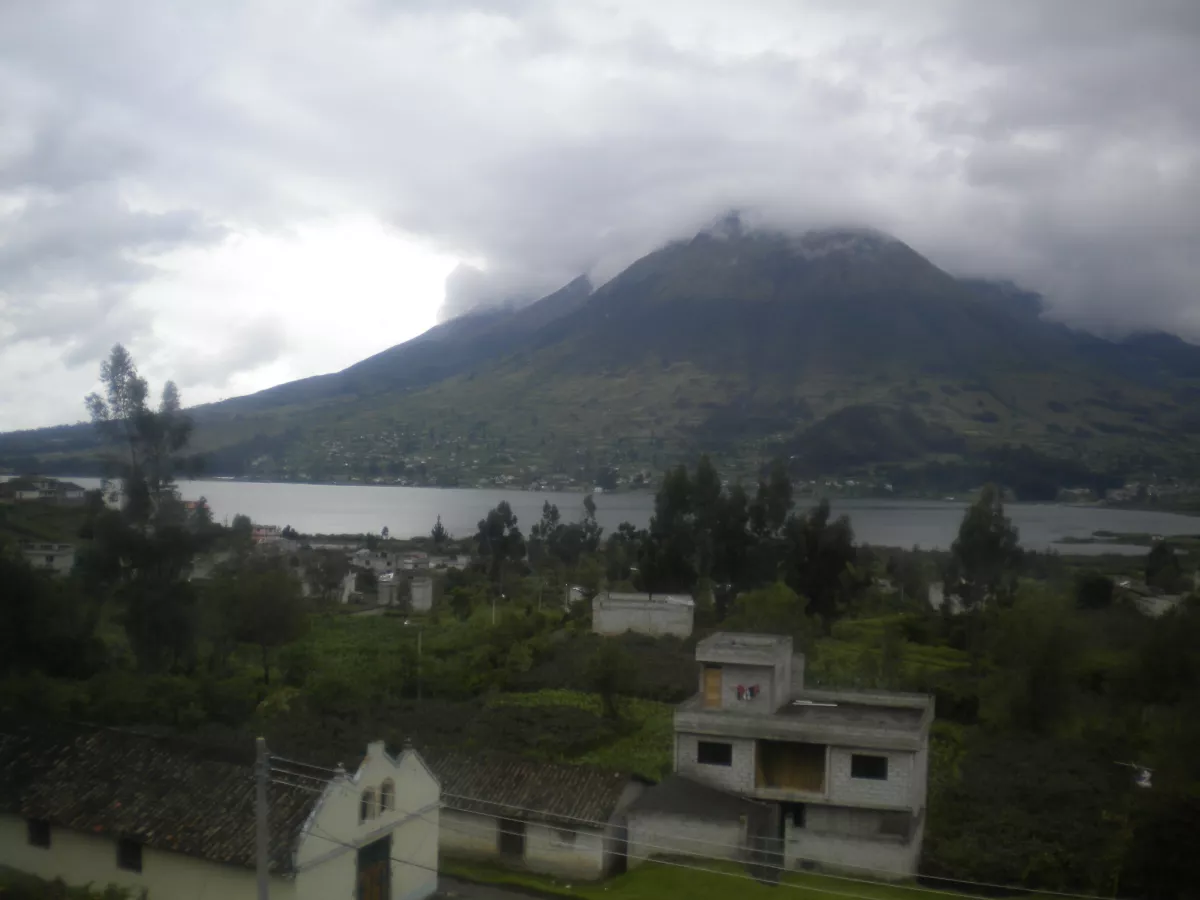
Photo by Stevie Lou Díaz
Now that I've recounted my journey to Quito I can set the stage for the actual fieldwork. When I was searching for fieldwork abroad, I had a few stipulations in mind. I already had a few years of experience working with frogs, turtles, and a bit of salmonids. I particularly wanted to work with what wildlife biologists deem "Charismatic Megafauna", or your big cats, your wolves, your bears. I also wanted to support local biologists. I was getting tired of reading American academics of non-American ecology. I wanted to see wildlife work from the other side. Working with the Andean Bear Project checked both boxes.
While signing up I received some information about the job detail. Two other women my age would be volunteering with me. It just so happened that the field project leader was taking another job and would not be with us during our 4 weeks. I guess all three of us were pretty brave because we signed on even with that caveat. Also, I would be the main Spanish-speaker. Yikes!
I met the project administrator and the other volunteers in Quito. We will call the British blonde, Liz, and the red-head from eastern U.S., Sara. Liz had a bunch of nice camera equipment and would be making a documentary because she was interested in film. Sara had previous experience in the Peace Corps. I spoke Spanish like a robot and came equipped with a chainsaw chain, a flint, and a compass.
We were headed to a remote area in the Andes outside Otavalo near Apuela. It was situated in the mountains of the Intag Valley. On our way we stopped by a grocery store to get supplies. I remember getting a bit of home sickness because the medium-sized grocery store was in a warehouse, and I found that strange at the time. If you want to picture this Ecuadorian grocery store from 13 years ago just go to a Dollar General in the U.S. today.
We took a bus from Quito that went along the Panamericana. We switched buses in Otavalo. On our way through Otavalo, I purchased a wool hat that fit like a glove. Unfortunately, I did not account for it shrinking on my head while in the clouds. So please, picture me in the rest of these stories with a minor headache, frequently pulling the brim of my hat apart during any idle time. Also, when I mention Otavalo or any town near Otavalo, you must hear men at every bus stop calling out “Oh-tuh-VAH-lo, Oh-tuh-VAH-lo, Oh-tuh-VAH-lo!” with emphasis on the third syllable. The towns we passed had many abandoned homes. Based on the reading I had done beforehand and conversations with the project’s local field technicians, I came to understand that the various Indigenous, ecological, and rural agrarian movements mixed with new and unstable infrastructure stopped what could have been a suburban sprawl. The economics of natural resource penetration and extraction was somewhat volatile. The large homes abounded mid-construction were evidence of a middle class disappeared.
Here is an excerpt from my Lonely Planet guide about arriving at the Intag Valley, ". . .the road plunges downward only to crawl out of mountain gutters and climb again. Sometimes mudslides block this road, but drivers, who may cross themselves before embarking, seem to have an uncanny talent for its narrow dimensions and ghastly conditions.” The description did not lie. The roads were scarily narrow, with incredibly shear cliffs (no guard rails), and had multiple landslides that would completely shut down a road in the U.S. The buses kept more or less to a schedule where they would not cross each other at any of the switch backs. The drivers were fast, the roads were dirt or mud, and the views were epic. Ecuadorian radio played a sort of bomba or cumbia that had a very continuous forward beat, much like an old-timey western movie soundtrack. I felt like I was essentially going back in time with a very frontiersman feel. The Andean mountains of Ecuador were very much a place of opportunity for homesteaders willing to carve their life into the steep mountainsides.
We met the lead Andean Bear biologist at the field project house. He and the volunteer coordinator spent a couple of days at the house allowing us time to discuss bear biology, look over maps, and review the use of radio telemetry. I notated in my travel journal that my line of questioning 'seemed to cause some unease'. At the time I thought it was a 'them' problem, however years later I have discovered my propensity for asking questions is actually off-putting to many people, especially those who regard themselves in authoritative roles. There's something about direct questions that makes people uneasy, especially if coming from a young woman.
On a positive note, I asked them if the male bears generally stuck to the ridge lines and the females to the valleys. I was referencing a paper I had read earlier about Italian brown bears. This would make sense because females, who need to rear their young, would probably stick to valleys where there's more food and they could generally keep to their own naturally delineated territories. Whereas males, who want access to many females and do not rear young, would stick to ridges making the many different valleys easily accessible. The biologist reviewed his notes that night and found it to hold true. This was a good exchange in academics, as he had not read that paper. He may not have had access to the scientific literature that I had while I attended a college in the U.S. Also, many scientific journals are published in English. This was years ago when you could not just copy paste large swaths of text into Google translator.
Even though we had a great academic exchange, I managed to call the biologist's young dog, "Stupid Dog" right in front of him. I tried to cover it up by saying in Spanish that he was a "young puppy". I do not think I fooled anyone. He told me he selected his dog with the goal to train him for tracking Andean bears and tapirs. Unfortunately, I did not hold the dog in high regard. Actually, I was enamored with one of the street dogs, Charlie.
Charlie looked like a shepherd mutt. He had a good size and form. He was smart. I got the feeling that I could train him to be a great dog, and after a few years, he would be loyal. I also had the feeling that prior to gaining his loyalty, if I were to fall and become injured out there in the forest with him, he would probably eat me while I was still alive. But, give it a few more years and he might not! I apologize for straying off topic (pun-intended) but street dogs are quite a theme with volunteers in other countries. I will say that I did not like 99% of the street dogs. They would track us while we were out walking. We would have to throw rocks at them to get them away. They would act friendly to your face, but once you turned your back on them, they would go back into predator mode. I prefer solo predators like big cats over dogs that hunt in numbers. Charlie, was a lone wolf. That's probably why I liked Charlie. In ancient times, I imagine you would want the dog that would choose you over the pack.
For those who might not know, radio telemetry can be used to track animals that have been tagged or collared with radio frequency emitters. Once an animal is tagged, you can hike or drive the area listening for its frequency using an antenna and receiver. Then you make notes on your map. This will give you its approximate location. As with the AM/FM radio, it is easier to get a signal by listening at higher elevations or in unimpeded areas. It is more difficult to pick up a frequency in dense and complicated terrain such as the cloud forests of the Andes. Depending on distance and terrain, and how specific you need to get, you may need to triangulate the location of an animal (or listen from three different spots).
The project was given donations of radio and GPS collars to test their efficacy in the difficult terrain. However, the Ecuadorian government, in an effort to promote their own industrial growth, required a 100% tax on all imported electronics. This is another insight into non-(North)American ecology and conservation I found interesting. Donations can be made to organizations but that does not mean it's easy for them to utilize it. It’s not that simple. Now, tariffs are a hot topic in the U.S. It is strange since my first real connection with tariffs involved the difficulty for a non-profit organization in a South American country to obtain electronic equipment for the conservation of a vulnerable flagship animal. I had to travel to another continent for that core memory that occurred years ago. Now it is all over the news.
Art Inspired Writing
Christina Donaldson
Several years ago, I attended a writing workshop at an art museum. Part of the experience for the participants was finding an art piece that called to us, sitting in front of it and writing whatever came to mind. Through this process I found that art was a powerful muse for my writing and I have continued to use it ever since. Since I no longer live near that art museum, often I’ll google an image, or try to find inspiration in art books. This particular piece was inspired by a painting found online of an abstract beach. Unfortunately I can no longer access the image of this painting, but I hope this piece may bring to you its own image of standing on a beach.
You called my name and all I wanted to do was crawl into the vastness of the ocean before me. I wanted to swim but feel warm, and held, safe from anyone or anything that could influence my being, my movement. I wanted space, solitude with nature. How many others had wanted the same but struggled to have it without effort? I began to think that many I saw or knew about could access this bliss whenever they wanted. And maybe that was true. How did they do that? How did they get what they wanted so easily while I seemed doomed to a life that would always be just out of reach. I wanted to blame everyone around me for that. They didn’t understand me, they didn’t get what I needed, and I struggled to have the courage and voice to name what that was. It had been hidden from me for so long that I struggled to even know what it was. What did I need?
But I knew. I had always known. And I was afraid of what I knew. I was afraid that what I needed created a distance from those around me, the implications of this isolating and painful. When I had what I thought I wanted, I was often if not always…alone. Alone in the sense of not having anyone else around me. Aloneness was nice, I loved the quiet, but when I wanted connection and closeness, I had to rip myself from this controlled space to a space that involved unknown and risk, the chance of being rejected. I couldn’t win. I may be rejected if I was alone, but also possibly rejected when I was together with others. How to make sense of this. Needs.
And maybe that was it. I could allow myself both. I could allow myself the need for sacred solitude and silence, to access the joyful bliss I longed for and which sustained me. And maybe, just maybe, I could love myself enough to be with others even when they were rejecting, or unkind, or judgmental, or so opinionated that it made my head swim, or just not able to understand me. If I could do that, if I could love myself through all of those interactions, then maybe, there would be more on the other side. I would find that kindness, gentleness, care, and even love that I yearned for in the company of others. Maybe it would be in the circle of loving community, the close bond of female friendship, the gaze of a kind stranger or the arms of a loving partner. Maybe I would find a way to feed both the calling to connect with the calling to retreat. And both would feed each other, not because that is what they were designed to do, but because I had created it that way, because I was allowing myself this reality, because I was a human among humans. I too could yearn, love and create. I too could need.
A Statement of Solidarity
As an autistic person who writes and publishes, I feel that I cannot not use this platform to address some of the things that are currently going on in the world. Neurodiversity liberation is, for me, a liberation from a colonial “normality” that normalizes hierarchies and oppression in all directions, resulting in violence towards people, and the planet as a whole. This is just a small magazine. However, I think that words always do matter.
I would like to join millions of people around the world in expressing solidarity with the people of Palestine who are, at present, suffering a genocide at the hands of the Israeli state, by means of mass military attacks, war crimes, and intentional starvation. My thoughts also particularly go to autistic people who are in Gaza, and facing such a situation. Autistic activist Greta Thunberg, and dozens of other people from across the globe, are, as I write, sailing towards Gaza on over 50 vessels, in order to break the military blockade, thereby filling the gap created by governments’ willful inaction. Israeli military has already repeatedly targeted the vessels in international waters.
While Palestine is rightly making news due to the genocidal nature of Israel’s acts, there is a number of other crises also happening across the world, largely as a result of global inequality and the profit-based arms industry. I am therefore writing this in solidarity with any person, both autistic and not, who is currently experiencing the effects of the injustice of this global system. For example as I am writing this, I am aware that the electronic technology of the laptop that allows me to type this words, is made with minerals that have most likely been extracted through the military exploitation of children in the Congo, which is a reminder that no aspect of our lives can be separated from the lives of others.
In Turtle Island, also called USA, a certain Orange Man has triumphantly announced this week that his team has “solved autism”, and autism is due to pregnant mothers taking Tylenol, and that Leucovorin (a form of folate) should be the “cure”. Aside from the obvious ridiculousness of these affirmations, they dangerously pave the way for a pathologization of autism of eugenicist nature, enforced medical interventions profiting pharmaceutical companies, excuses for privacy violations, and interference with reproductive rights – goals which all fit with the Trump administration’s clear attempt to establish a racist dictatorship.
This is not a political magazine, however, as they say, “you can’t be neutral on a moving train”, and god knows the train has been moving lately. In my view, this is not about picking factions but about sustaining fundamental human values, which I hope can remain at the core of the emerging movement for neurodiversity recognition.
Bathrobe Comics: Trees
Sarah Jane Cody
First published on Dec 31, 2024, on the Bathrobe Gal website
My New Year’s resolution is to be fully myself, now that I finally understand myself.
When I finally found out the truth, that I was just a different type of human––an autistic human––I was still pretty confused at first. Ultimately, it changed my life. I’m so grateful for the autistic community I’ve found who’ve collectively helped me find great understanding, resources, and the confidence to wholly embrace the being I am.
And I’m deeply grateful for the support of other friends and family who accept me and love me as I am.
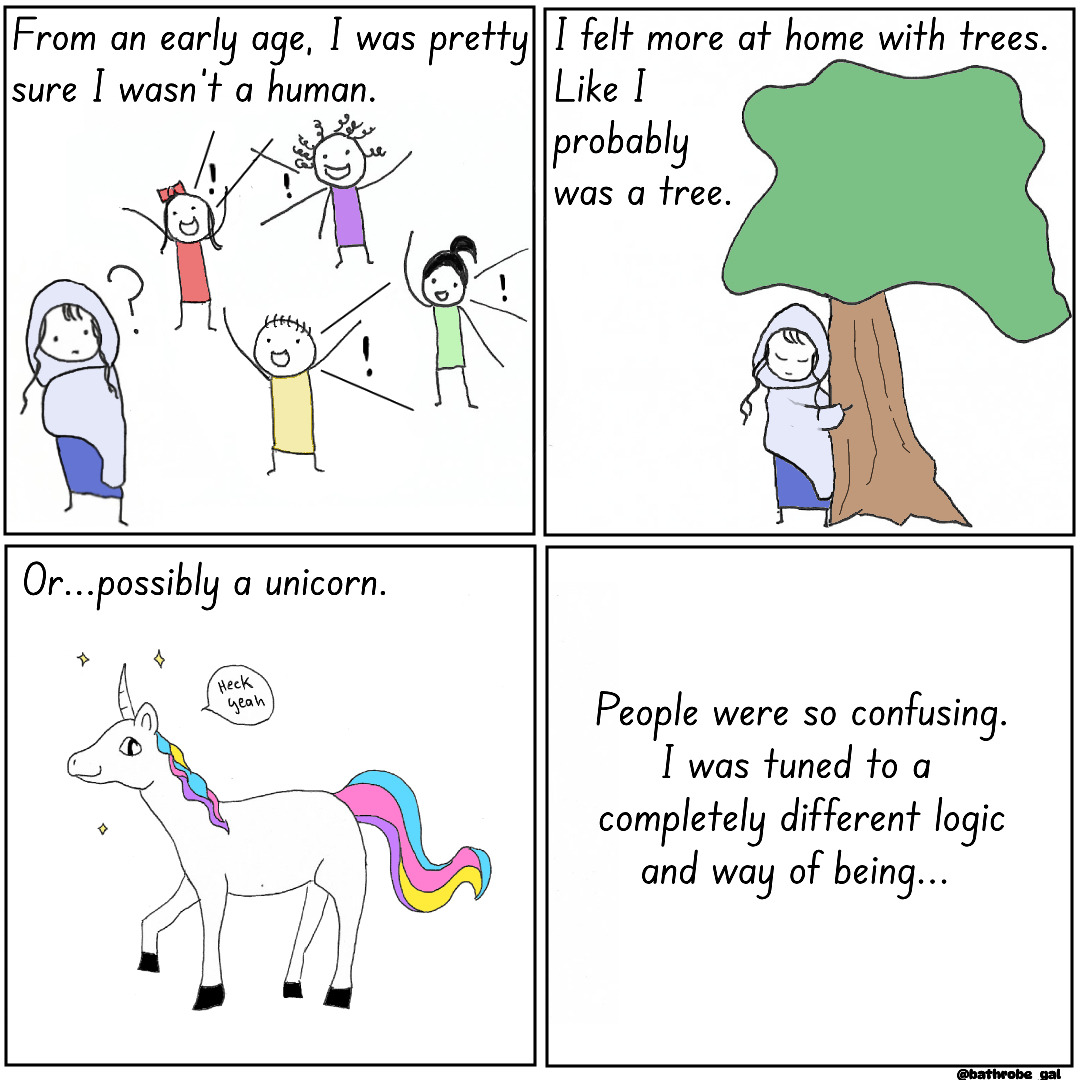
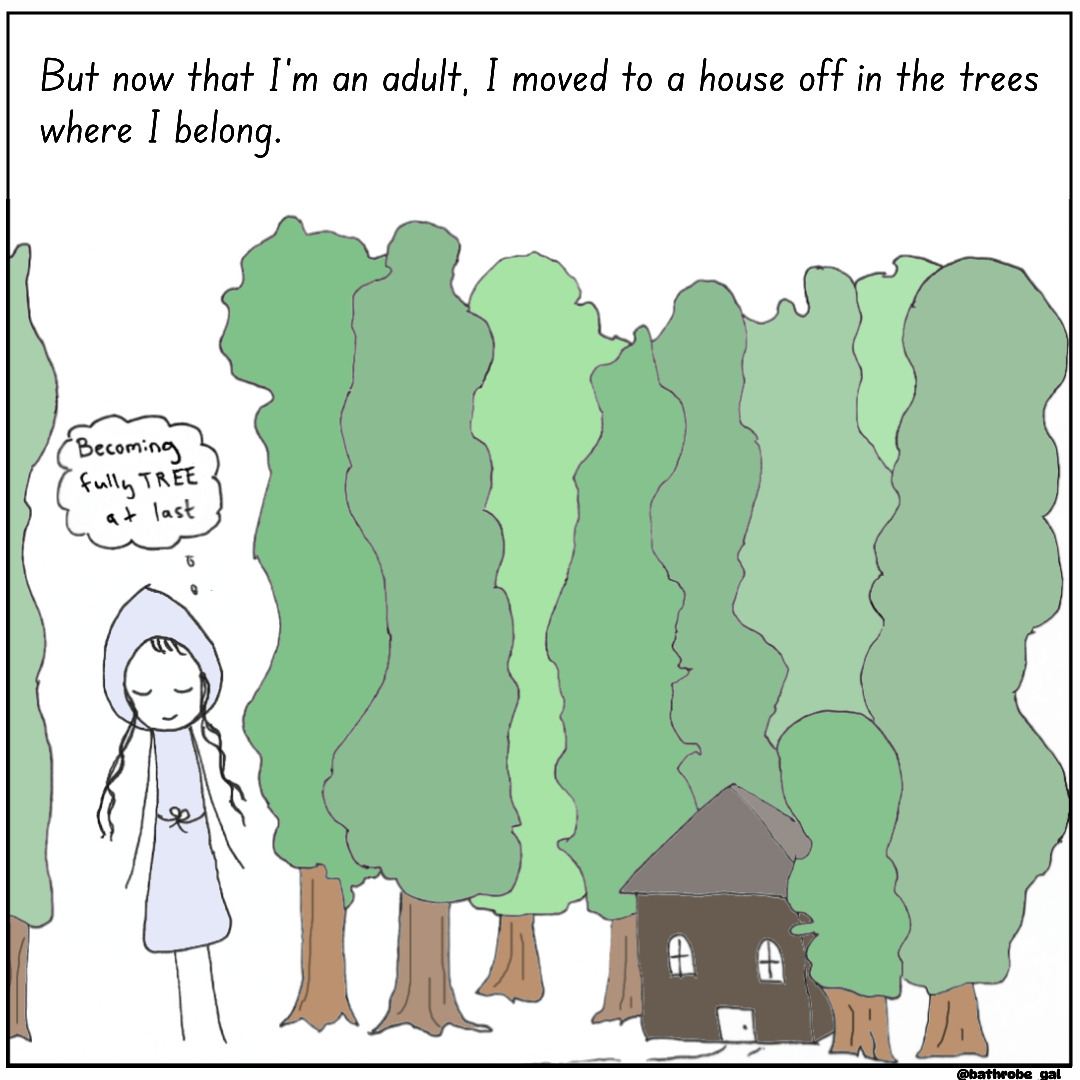
Sticker: Introvert
Elissa Fox
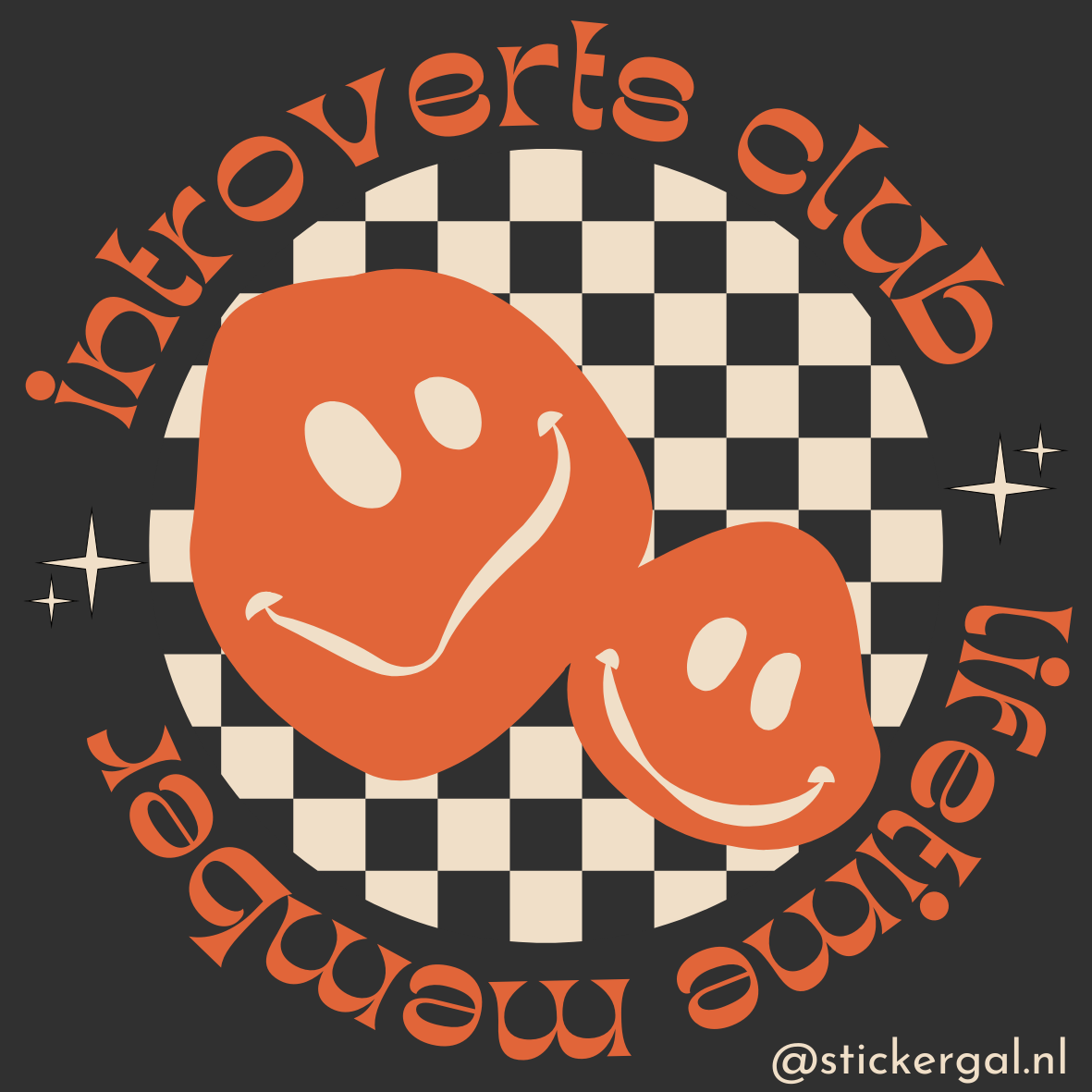
Classifieds
Please use caution when communicating outside AWG meetings
Participate in a study on adult autistic women in higher education
Michaela Fanelli, neurodivergent researcher, educator, and educational administrator
I’m conducting a study exploring how women diagnosed with autism spectrum disorder (ASD) experience and persist in higher education.
I’m looking for:
- Women with a formal ASD diagnosis
- Currently enrolled in a 4-year college or university
- Willing to participate in a 45–60 minute Zoom interview
- Complete a short questionnaire after being interviewed
- This research aims to amplify lived experiences and inform more inclusive, identity-responsive practices in postsecondary education.
- Participants will be entered into a $100 Amazon gift card drawing as a thank you!
Interested or know someone who might be? Complete the brief eligibility screener here: https://autisticwomenincollege.as.me/
About the researcher:
Michaela Fanelli identifies as neurodivergent, a self-recognition that has deepened her understanding of inclusion and informed both her professional practice and scholarly work. She holds a bachelor’s degree in Early Childhood Education and a master’s degree in Education with Board Certified Behavior Analyst (BCBA) credentials. Michaela is currently pursuing a Doctor of Education in Higher Education Leadership, where her research examines neurodiversity-affirming practices and institutional culture in postsecondary education. With over a decade of experience supporting autistic students, she has served as a paraprofessional, BCBA, Assistant Principal, and now as Manager of Professional Development and Learning at a school dedicated to autistic education. Her work centers on developing equitable, inclusive learning environments through culturally responsive, evidence-based, and neurodiversity-affirming professional development. Michaela’s neurodivergent identity continues to guide her leadership, advocacy, and commitment to bridging research and lived experience to promote authentic inclusion across educational systems.
